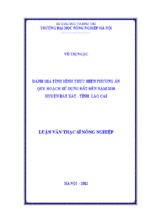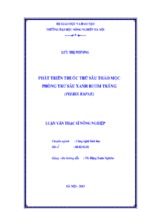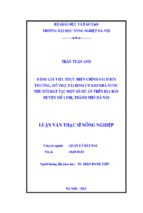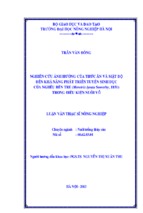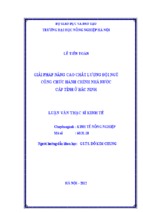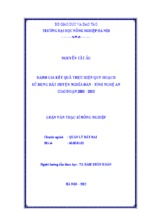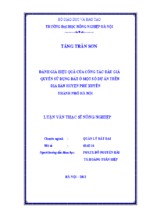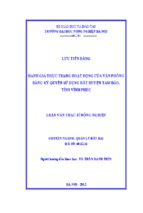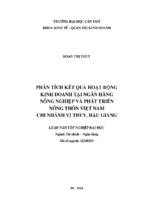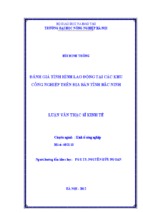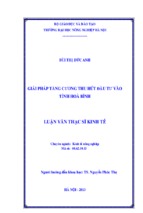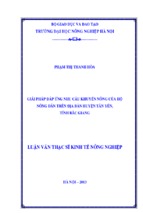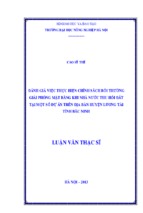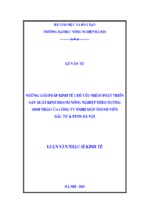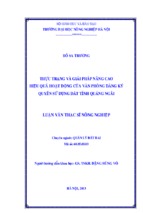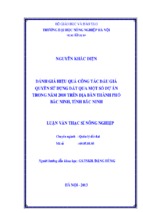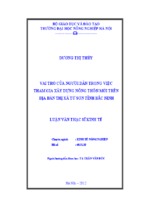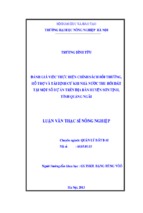THAI NGUYEN UNIVERSITY
SCHOOL OF FOREIGN LANGUAGES
DUONG THI DUNG
APPLYING THE PROJECT-BASED LEARNING (PBL) TO
ENGLISH SPEAKING SKILL ENHANCEMENT FOR GRADE 10
STUDENTS AT CUA ONG HIGH SCHOOL,
QUANG NINH PROVINCE
(Áp dụng phương pháp học theo dự án để nâng cao kỹ
năng nói cho học sinh lớp 10 tại Trường THPT Cửa Ông,
tỉnh Quảng Ninh)
M.A. THESIS
Field: English Linguistics
Code: 8220201
THAI NGUYEN – 2019
1
THAI NGUYEN UNIVERSITY
SCHOOL OF FOREIGN LANGUAGES
DUONG THI DUNG
APPLYING THE PROJECT-BASED LEARNING (PBL) TO
ENGLISH SPEAKING SKILL ENHANCEMENT FOR GRADE 10
STUDENTS AT CUA ONG HIGH SCHOOL,
QUANG NINH PROVINCE
(Áp dụng phương pháp học theo dự án để nâng cao kỹ
năng nói cho học sinh lớp 10 tại Trường THPT Cửa Ông,
tỉnh Quảng Ninh)
M.A. THESIS
(APPLICATION ORIENTATION)
Field: English Linguistics
Code: 8220201
Supervisor: Prof. Dr. Dang Thi Thu Huong
THAI NGUYEN – 2019
2
THE CANDIDATE’S STATEMENT
I hereby declare that this graduation project is based on my original work
except for quotations and citation that have been duly acknowledged. I also declare
that it has not been previously or concurrently submitted for any other
courses/degrees at Thai Nguyen University or other institutions.
The candidate
Duong Thi Dung
Approved by
SUPERVISOR
Dr. Dang Thi Thu Huong
i
ACKNOWLEDGEMENT
This research was the result of my hard work with the great support of many
people. I want to express my hearty gratitude and appreciation to my supervisor for
her patience, kindly support and useful advices during the time I conducted my
research. But for his precious comments and instructions, the thesis could not have
done effectively.
Secondly, I do appreciate the tremendous support from my school – Cua Ong
High School. I would like to give many thanks to the students who directly engaged
in the lessons throughout the process of data collection. Their enthusiasm and
serious contribution made the process of data collection effective and reliable. I also
acknowledge my thankfulness to my headmaster who helped facilitate my research
conducted smoothly.
Another special thank goes to teachers of English Department, School of
Foreign Languages, Thai Nguyen University. Without their advices and
encouragement, I would not have been able to pursuit my research.
Last but not least, my endless thanks approve to my family for their time,
encouragement, motivation and support me on my way of study.
Thai Nguyen, June 2019
Duong Thi Dung,
ii
ABSTRACT
This research tries to attempt to know the effect of project-based learning
(PBL) toward speaking ability and its effective implementation. Accordingly, this
research applied a quantitative design for the first stage. Population in this research
was the grade 10 grade students of the two classes 10A1 and 10 A2 in Cua Ong
High School. The total numbers of the respondents are 70 students. The researcher
used questionnaires, test, observation and interview as data collection. Since the
hypothesis is intended to find the effect of the PBL toward students’ speaking
ability, the Simple Linier Regression by using SPSS 19.00 for Windows was
applied. The second phase, the result of observation and interview were analyzed by
Miles and Huberman’s view of qualitative data analysis consisting of data
reduction, data display, and drawing conclusion. The result of analysis showed that
there was significant effect of Project-Based Learning toward students’ speaking
ability. Moreover, the effective procedures for the implementation of Project-Based
Learning are (a) dividing the class into groups, (b) explaining the project and (c)
performing the project. Finally, the students showed significantly positive attitude
toward the implementation of PBL in speaking class.
iii
TABLE OF CONTENTS
LIST OF ABBREVIATIONS.............................................................................. VII
LIST OF TABLES & FIGURES ....................................................................... VIII
PART 1: INTRODUCTION.....................................................................................1
1. RATIONALE ..........................................................................................................1
2. AIMS OF THE STUDY.............................................................................................2
3. RESEARCH QUESTIONS .........................................................................................2
4. SCOPE OF THE STUDY ...........................................................................................3
5. DESIGN OF THE THESIS .........................................................................................3
PART 2: DEVELOPMENT .....................................................................................3
CHAPTER 1: LITERATURE REVIEW ................................................................3
CHAPTER 2: RESEARCH METHODOLOGY ...................................................3
CHAPTER 3: FINDINGS AND DISCUSSION .....................................................3
PART 3: CONCLUSION AND RECOMMENDATION ......................................3
PART 2: DEVELOPMENT .....................................................................................5
CHAPTER 1: LITERATURE REVIEW ................................................................5
1.1 CONCEPTS OF SPEAKING SKILLS ........................................................................5
1.1.1 Definitions ...................................................................................................5
1.1.2 Types of speaking ........................................................................................6
1.2 TEACHING ENGLISH SPEAKING ..........................................................................8
1.2.1 Concepts of English-speaking teaching ......................................................8
1.2.2 Anxiety ........................................................................................................9
1.3 WHAT IS PBL? .................................................................................................10
1.3.1 Definitions .................................................................................................10
1.3.2 Types of PBL .............................................................................................11
1.3.3 Principles of PBL ......................................................................................12
1.3.4 Benefits of PBL in English teaching .........................................................12
1.3.5 Steps for implementing a PBL project ......................................................14
iv
1.4 Definition of learner’s motivation
1.4.1 The impacts of PBL to the learners’ motivation
1.5 PREVIOUS STUDIES ...........................................................................................18
CHAPTER 2: RESEARCH METHODOLOGY .................................................20
2.1 SOME DEFINITIONS ...........................................................................................20
2.2 METHODS OF THE STUDY .................................................................................20
2.3 DATA COLLECTION INSTRUMENT .....................................................................22
2.3.1 The respondents ........................................................................................22
2.3.2 Data collection procedures.......................................................................23
2.4 DATA ANALYTICAL METHOD ...........................................................................23
CHAPTER 3: FINDINGS AND DISCUSSION ...................................................25
3.1 RESULTS OF QUESTIONNAIRES .........................................................................25
3.1.1 The main motivation for English learning ................................................25
3.1.2 The motivating factors for learning English.............................................26
3.1.3 The interested PBL activities ....................................................................28
3.1.4 The level of satisfaction with PBL methods ..............................................29
3.1.5 The current level of motivation .................................................................30
3.2 OBSERVATION RESULTS ...................................................................................30
3.3 INTERVIEW RESULTS ........................................................................................32
PART 3: CONCLUSION AND RECOMMENDATIONS ..................................34
1. CONCLUSION ......................................................................................................34
2. LIMITATIONS OF THE STUDY ..............................................................................35
3. SUGGESTIONS FOR FURTHER STUDY ..................................................................35
REFERENCES ........................................................................................................36
APPENDIXES ........................................................................................................... I
APPENDIX 1: QUESTIONNAIRE ........................................................................ I
APPENDIX 2: INTERVIEW GUIDE ...................................................................III
APPENDIX 3: LESSON PLAN: DRAMA PERFORMANCE ............................ IV
v
vi
LIST OF ABBREVIATIONS
ABBREVATION
FULL MEANING
PBL
Project-based Learning
SPSS
Statistical Package for the Social Sciences
vii
LIST OF TABLES & FIGURES
Figure 1.1 Types of oral languages .............................................................................6
Figure 3.1 The main motivation for English learning ...............................................23
Figure 3.2 The motivating factor “Teaching equipment” .........................................24
Figure 3.3 The motivating factor “Learning program” .............................................25
Figure 3.4 The motivating factor “Teaching methods” ............................................25
Figure 3.5 The interested PBL activities ...................................................................26
Figure 3.6 Level of satisfaction with PBL methods..................................................27
Figure 3.9 The current level of motivation ...............................................................28
viii
PART 1: INTRODUCTION
1. Rationale
It is obvious that English is nowadays significantly considered as a language
of international communication, which is used worldwide for most of the fields
such as technology, education, business and trade. Regarding the context of
Vietnam, in recent years, the trend of global integration has raised awareness about
the importance of English teaching and learning in schools. Especially, speaking is
usually deemed one of the core skills in foreign language learning and it is also the
target that English learners generally are willing to reach. According to Richards
and Willy (2002), a majority of language learners in the world study English with
the purpose of being fluent in speaking.
In order to develop learners’ English-speaking proficiency, it is necessary for
them to master both knowledge and other subskills of speaking. This means that
they need to understand all aspects engaged with speaking skill. Burns and Joyce
(1997) stated that the sufficiency of the speaking skills includes a variety of tactics
and knowledge about the ways in each specific situation. In the same viewpoint,
Thornbury (2005) also agreed that to achieve the mastery of English speaking,
learners have to be good at both linguistic knowledge and practicing
communication. Due to its requirements, English teachers often encounter with
numerous challenges in English speaking teaching.
In Cua Ong High School, Quang Ninh province, English speaking has become
a compulsory part for all the teachers and the speaking time often accounts nearly
40% of total English lessons. The main objective is to help the students to better
their English-speaking skills, especially enables them to be confident in simple
monologues and dialogues as well as to communicate in daily conversations. To
achieve this goal, the teachers have to take responsibility of raising students’
speaking skill through providing various activities and materials in speaking
lessons. Especially with the grade 10 grade students, it may become difficult for
1
them to be familiar with learning English communication through practical
exercises.
Responding to the challenge, PBL, therefore, is often applied effectively and
efficiently in English speaking teaching. PBL can be understood as an authentic
learning or organizing model in which students plan, implement and evaluate
projects that includes real-life situations beyond the classroom (Doppelt & Yaron,
2003). It is also defined as the methods based on the constructivism by supporting
student engagement in problem-solving situation. Hence, a successful PBL helps
increase learners’ learning motivation, learning autonomy, and most importantly,
enhance their speaking skills to master English communication.
Concerned with the English teaching in Cua Ong High School, it seems that
PBL can be applied in English speaking enhancement for grade 10 students in the
school. Referring the successful implementation of PBL in different schools in the
world, this research aims at applying the approach in the context of Vietnam,
specifically, with grade 10 students in Cua Ong High School, Quang Ninh province.
2. Aims of the Study
The research aims to achieve the objectives as bellows:
• To explore the main motivation of the English-speaking teaching and
learning at grade 10 in Cua Ong High School.
• To discover the effects of the PBL on students’ English-speaking
performances.
• To find out why students at grade 10 in Cua Ong High School are fond of
learning speaking Enghlish basing on PBL.
3. Research questions
Therefore, in order to fulfill the above-mentioned aims, the following research
questions must be answered:
• What is the main motivation of students at grade 10 in Cua Ong High
School in learning speaking Enghish?
• Does PBL have effects on students’ learning English-speaking?
2
• Why does PBL make students at grade 10 in Cua Ong High School
interested in English-speaking teaching and learning?
4. Scope of the study
The research scope includes the two classes, namely class 10A1 and class
10A2 at Cua Ong High School, Quang Ninh province. They are selected to be the
participants of the study. The experiments of study will be conducted in speaking
lessons where the researchers use the PBL to enhance their English-speaking skill.
5. Design of the thesis
Part 1: Introduction
The first chapter will introduce an overview about the research topic,
including the rationale for the study, aims of the research, research questions, the
significance of the study as well as the organization of this thesis.
Part 2: Development
Chapter 1: Literature Review
In this chapter, the author will mention the related theories and previous works
to the research problem. For this study, the literature consists of the concepts of
speaking skills and teaching English speaking; the definitions of PBL and its types
and criteria, and the previous works on the application of PBL in teaching English.
Chapter 2: Research Methodology
This chapter aims to introduce how the research is conducted, describing the
methodological approach, data collection, sampling techniques and data analysis for
the research.
Chapter 3: Findings and Discussion
This part shows the results and the analysis to answer the research questions as
well as to make discussion on the research findings. In addition, this part also gives
important points and practical implications arising from this study in comparison
with previous studies in the Literature Review.
Part 3: Conclusion and Recommendation
3
Based on the research findings, this section aims to propose the
recommendations for the application of PBL in teaching English speaking skills for
grade 10 students in Cua Ong High School, and suggestion for further research with
the same concern.
4
PART 2: DEVELOPMENT
CHAPTER 1: LITERATURE REVIEW
1.1 Concepts of Speaking Skills
1.1.1 Definitions
Considering a language as a means of communication among people, a lot of
linguists define speaking skills by referring to the ability of using a language in oral
communication. In other words, it is stated that speaking skill is the ability to
function in the language in terms of being able to speak the language, in order to
express his or her idea to other (Nunan, 1999; Peter, 2002) also adds that speaking
is called social skill due to the interaction between more than one person who sends
a message in one side and receives it in another side. Hence, it means that in the
process of speaking, there must be at least one speaker, one receiver and a message
communicated. Accordingly, when an oral conversation is made, one speaks – send
messages to the listener, the receiver will listen to him/her and vice versa. Hence, it
is undeniable that speaking is obviously irrelated to listening skill.
In this regard, it is undeniable about the equal importance of both sender and
receiver in the conversation. Concerning to the viewpoint, Peter (2002) stated that
one of the main characteristics of a conversation is its reciprocity, since in most
speaking situations, the receiver of the message is in close proximity to the speaker.
It implies that in the conversation the speaker and the receiver may alternately tell
and listen, even interrupt one another. Thus, it differs from public speaking in which
the roles of speakers and listeners remain stable.
Despite a various concept of speaking, in the scope of this research, speaking
skill is understood as the ability to use a language by means of oral communication,
in which there must be at least a speaker (sender) and a listener (receiver) and their
role is changeable between them.
5
1.1.2 Types of speaking
Brown (2001) says that much of our language teaching is devoted to
instruction in mastering English conversation. He classifies the types of oral
language as the figure below:
Figure 0-1.1 Types of oral languages
Source: Brown, 2001
In monologues, when one speaker uses spoken language, as in speeches,
lectures, readings, and news broadcast, the listener must process long stretches of
speech without interruption-the stream of the speech will go on whether or not the
hearer understands. In planed, as it opposed to unplanned, monologue differs
considerably in their discourse structures. While dialogues involve two or more
speakers and can be subdivided into those exchanges that promote social
relationship (interpersonal) and those for which the purpose is to convey
proportional or factual information (transactional).
Brown (2001) also points out the types of classroom speaking performance as
bellows:
1. Imitative
6
A very limited portion of classroom speaking time may legitimately be spent
generating “Human tape-recorder” speech, where, for example, learners practice an
intonation contour or try to pinpoint a certain vowel sound. Imitation of this kind is
carried out not for the purpose of meaning full interaction, but for focusing on some
particular element of language form.
2. Intensive
Intensive speaking goes one-step beyond imitative to include any speaking
performance that is designed to practice some phonological or grammatical aspect
of the language. Intensive speaking can be self-imitated or it can even from part of
some pair work activity, where learners are “going over” certain forms of language.
3. Responsive
The students’ speech in the classroom is responsive short replies to teacher-or
students-initiated questions or comment. These replies are usually sufficient and do
not extend into dialogues. Such speech can be meaningful and authentic.
4. Transactional (dialogue)
Transactional dialogue, which is carried out for the purpose of conveying or
exchanging specific information is to extend form of responsive language.
Conversation, for example, may have more of a negotiate nature to them than does
responsive speech.
5. Interpersonal (dialogue)
Interpersonal dialogue carried out more for maintaining social relationship
than for the transmission of the facts and information. The conversations are little
trickier for learner because they can involve some or all of the following factors: a
casual register, colloquial language, emotionally charged language, slag, ellipsis,
sarcasm, and a covert “agenda”.
6. Extensive (monologue)
7
Students at intermediate to advanced level are called on to give extended
monologues in the form of oral reports, summaries, or perhaps short speeches. In
this, the register is more formal and deliberative.
1.2 Teaching English speaking
1.2.1 Concepts of English-speaking teaching
Nunan (2003) defines the meaning of “teaching speaking” as teaching English
learners to: (1) Produce the English speech sounds and sound patterns; (2) Use word
and sentence stress, intonation patterns and the rhythm of the second language; (3)
Select appropriate words and sentences according to the proper social setting,
audience, situation and subject matter; (4) Organize their thoughts in a meaningful
and logical sequence; (5) Use language as a means of expressing values and
judgments; (6) Use the language quickly and confidently with few unnatural pauses,
which is called as fluency.
On the other way around, teaching speaking has been undervalued and English
language teachers teach speaking just in the forms of a repetition of drills or
memorization of dialogues. It should be now extended that the goal of teaching
speaking is not merely to force them to make the English utterances but it should
cover the mastery of students’ communicative skills due to the fact that only in that
way, students can express themselves and learn how to follow the social and
cultural rules appropriate in each communicative circumstance. To do so, learners
should be given an opportunity to work in interactive mode to talk about themselves
in personally relevant ways. This demands such new dimension to the language
learning process.
Taking teaching English speaking into consideration, Bashir (2011) proposed
three areas of knowledge that the English learners need to be taught, including: (1)
mechanics, which involves with pronunciation, grammar and vocabulary. The
mastery of mechanics means that the learner can use the right words in the right
order with exact pronunciation; (2) function, including transaction and interaction.
It requires a clarity of message when exchanging information and a precise
8
understanding when receiving the message; and (3) social and cultural rules and
norms, which refer to turn-taking, rate of speech, length of pauses between speakers
and class of speakers. Accordingly, the participants in the conversation need to
know who is speaking to whom, what to say, in what circumstance and for what
reason.
And for the teachers, like any other subject, in the beginning, the teachers
need to find out the current level or background capability of the students to select
the appropriate teaching methods. Regarding to English speaking teaching, Burns
and Joyce (1997) agree that before an English teacher decide to teach speaking skill,
they have to assess the students’ current level of language competency and
proficiency. It is based on collecting personal information of the students such as
age, language background and students’ need and goal.
1.2.2 Anxiety
Students should feel comfortable in sharing their feeling and opinions even
some cultures consider it as improper values to talk about one. Teachers’ attitudes
to respond the students thought and opinion is also important as they should not be
forced to speak, they should be heard and respected, and they should extend the
same courtesy to their classmates. Teachers should realize that students often feel
difficult and as a consequence, teachers should avoid expressions of negative
feelings. Such attitude is expected to reduce the student anxiety of making mistakes
and they will have courageous to speak.
Anxiety, simply speaking, is a kind of troubled feeling in the mind. It is a
subjective feeling of tension, apprehension, nervousness, and worry associated with
an arousal of the automatic nervous system (Horwitz, 1986).
Krashen (1985) maintained that anxiety inhibits the learner’s ability to process
incoming language and short-circuits the process of acquisition. An interaction is
often found among anxiety, task difficulty, and ability, which interferes at the input,
processing, retrieval, and at the output level. If anxiety impairs cognitive function,
9
students who are anxious may learn less and also may not be able to demonstrate
what they have learned.
Furthermore, Crookall and Oxford (1991) reported that serious language
anxiety may cause other related problems with self-esteem, self-confidence, and
risk-taking ability, and ultimately hampers proficiency in the second language.
MacIntyre and Gardner (1991) found that speaking is by far the main agent of
anxiety-arousal, and that students with high anxiety perform worse than those with
low anxiety. According to Young (1991), there are six potential causes of language
anxiety that include personal and interpersonal, learner beliefs about language
learning, instructor beliefs about language teaching, instructor-learner interactions,
classroom procedures and language tests.
However, to date, findings by Horwitz, Horwitz and Cope (1986) have been
the most influential. They identified three causes of language anxiety, that is,
communication apprehension, test anxiety, and fear of negative evaluation.
Based on the above definition, anxiety is a kind of troubled feeling in the
mind, which covers a subjective feeling of tension, apprehension, nervousness, and
worry associated with an arousal of the automatic nervous system. There are three
causes of anxiety; they are (1) communication apprehension, (2) the test, and (3) the
fear of making mistakes in producing the language.
1.3 What is PBL?
1.3.1 Definitions
PBL has been defined in many ways. For this reason, there exists no single
definition. PBL is based on the constructivist learning theory, which finds that
learning is deeper and more meaningful when students are involved in constructing
their own knowledge. Constructivism is a theory based on observation and scientific
study about how people learn. People construct their own understanding and
knowledge of the world, through experiencing things and reflecting on those
experiences (Vygotsky, 1978). When we encounter something new, we have to
connect it with our previous ideas and experiences, it may change what we currently
10
- Xem thêm -

